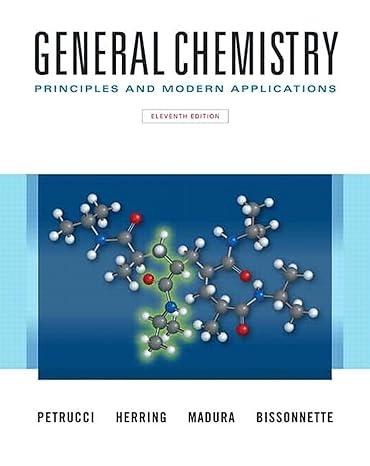(A) Melamine is a carbonhydrogennitrogen compound used in the manufacture of adhesives, protective coatings, and textile finishing...
Question:
(A) Melamine is a carbon–hydrogen–nitrogen compound used in the manufacture of adhesives, protective coatings, and textile finishing (such as in wrinkle-free, wash-and-wear fabrics). Its mass percent composition is 28.57% C, 4.80% H, and 66.64% N. The melamine molecule features a six-member ring with alternating carbon and nitrogen atoms. Half the nitrogen atoms and all the H atoms are outside the ring. For melamine,
(a) Write a plausible Lewis structure,
(b) Describe bonding in the molecule by the valence bond method, and
(c) Describe bonding in the ring system through molecular orbital theory.
(B) Dimethylglyoxime (DMG) is a carbon–hydrogen–nitrogen–oxygen compound with a molecular mass of 116.12 u. In a combustion analysis, a 2.464 g sample of DMG yields 3.735 g CO2 and 1.530 g H2O. In a separate experiment, the nitrogen in a 1.868 g sample of DMG is converted to NH3(g) and the NH3 is neutralized by passing it into 50.00 mL of 0.3600 M H2SO4(aq). After neutralization of the NH3 the excess H2SO4(aq) requires 18.63 mL of 0.2050 M NaOH(aq) for its neutralization. Using these data, determine for dimethylglyoxime
(a) The most plausible Lewis structure, and
(b) In the manner of Figure 11-19, a plausible bonding scheme.
Figure 11-19
![T: (2p)-0(2p) H o: H(1s)-C(sp) 120C= H 120 o: C(sp)-0(2p) [or, o: C(sp)-0(sp)]](https://dsd5zvtm8ll6.cloudfront.net/images/question_images/1699/9/5/7/32465534a4c3eead1699957323151.jpg)
Step by Step Answer:

General Chemistry Principles And Modern Applications
ISBN: 9780132931281
11th Edition
Authors: Ralph Petrucci, Jeffry Madura, F. Herring, Carey Bissonnette





